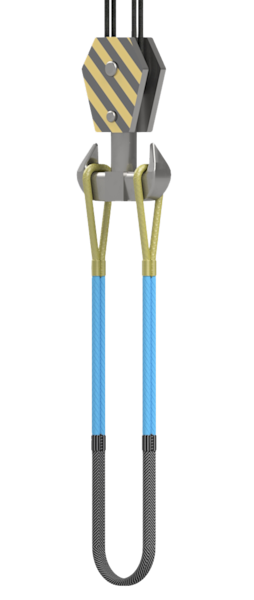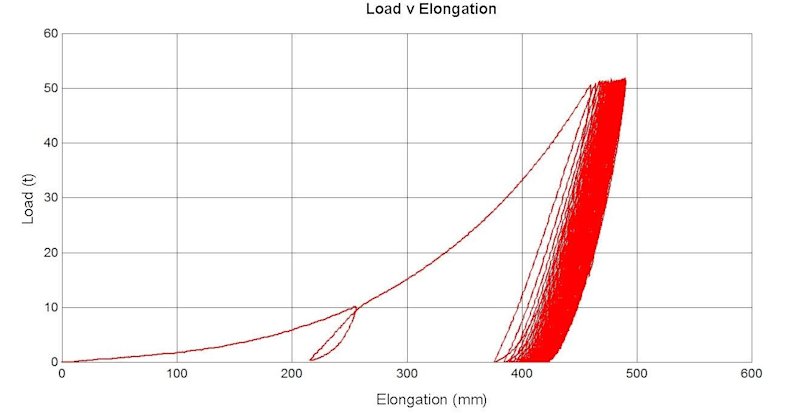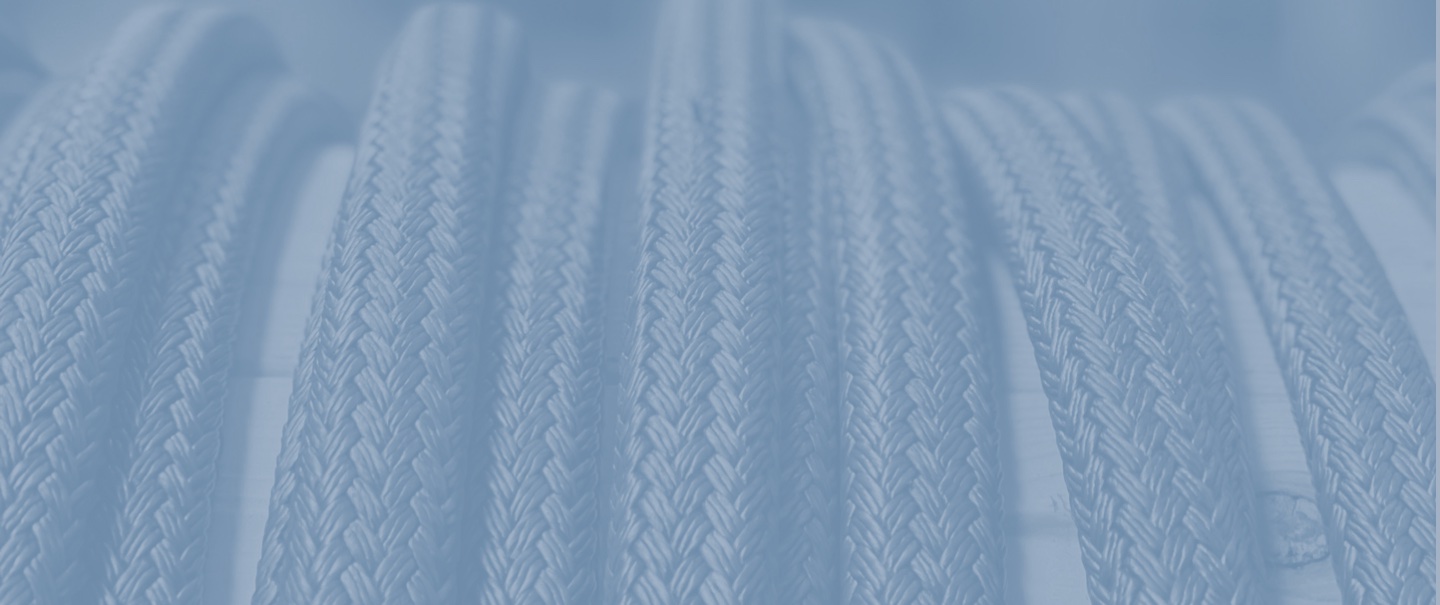- Dynamica Ropes
- Products
- SafeLift Slings
Dynamica SafeLift Rope Slings
Dyneema/HMPE rope slings

Technical information
| Construction | Single, double |
| Rope material | HMPE/Dyneema® |
| Body cover | HMPE/Dyneema®, Dual Cordura |
| Eye cover material | HMPE/Dyneema®, Dual Cordura |
| MBL | Up to 6000 t |
| Diameter | Up to 200 mm |
| Length | Unlimited |
| Length tolerance | +/- 2 % or less |
| Length tolerance, matched pairs | 1 % or less |
| Safety | Proof Loaded |
| Safety factor | According to customer specifications |
Need a datasheet?Go to solution request and fill in your details | |
Features
- Strong as steel
- 10 times lighter than steel
- High length precision
- Abrasion resistant
- Increased crane load capacity
- Proof loaded
- Safer handling
Applications
- Lifting
Why choose Dynamica synthetic SafeLift rope Slings?
The unique feature of Dynamica SafeLift Slings is the Proof Loadwhich we provide for each and every sling manufactured at our premises. The proof load ensures on the one hand a safe lifting operation, on the other hand that the effective working length (EWL) of the sling is defined even before the first lift, meaning there is no need for 'training' the sling.
All Dynamica SafeLift Slings are made with HMPE/Dyneema® and are manufactured according to DIN EN 1492-4. Every sling is made with safety in focus.
Dynamica Rope slings are used for any onshore and offshore lifting operation and custom-madeto provide the best possible lifting equipment for the specific lifting operation.
The rope slings are constructed as a single or double sling with a variety of options when it comes to covers and extra protection against abrasion.
Dynamica Safelift Slings are made with HMPE/Dyneema®, which is classified as the strongest fibre in the world, also known as Ultra High Molecular Weight Polyethylene (UHMWPE). These properties make HMPE/Dyneema® fibres the best choice for heavy lifting slings.
The low weight combined with unique strength makes SafeLift Slings the perfect alternative for steel wire slings or traditional polyester slings.
Interested in a Dynamica SafeLift Sling? Get more information or a quotation through Solution Request.
Synthetic Rope Sling Construction
All Dynamica SafeLift Slings are made with HMPE/Dyneema® and are manufactured according to DIN EN 1492-4.
Every sling is custom-made with quality and safety in focus.
The rope slings are constructed as a single or double sling with a variety of options when it comes to covers and extra protection against abrasion.
Single sling

Double Sling

Lifting configuration
When you choose to use Dynamica SafeLift Slings it is important that you define the application and the configuration, so that you choose the best sling and best protection to handle and control your load. Selecting the correct configuration is as important as choosing your lifting sling.
Any load can be rigged and moved in many ways, therefore, there are a few different types of configurations that will assist you with the requirement.
Straight lift
Straight lift (vertical configuration) is the most common one of all. The crane hook connects the sling at the top, and the opposite eye of the sling is connected to the lifted structure. This type of lifting configuration requires protection in the bearing points only.

U-lift
The u-lift configuration distributes the load equally between the two legs of a sling. The legs have to be well protected in case they are not rigged on trunnions but in contact with the cargo like in case of monopole lift. The same goes for the bearing point where the sling is wrapped around the load. When using a basket configuration, the load is supported by the two parts of the sling and then connected to a crane hook.

Proof Loading
Dynamica rope slings have an integrated splice connecting the rope into the sling. The elongation of a spliced rope is caused by the alignment of the fibres in the splice under tension. The sub strands and strands of the rope in the splice align when the rope sling is loaded. The elongation caused by splice setting can be removed by Proof Loading in our Test Bed. All rope slings made by Dynamica Ropes are Proof Loaded up to 500 t in our in-house Test Bed or at external facilities, if the Proof Load exceeds 500 t.
Improved higher safety in lifting operations
By Proof Loading the slings before use you are sure that the rigging you are going to use has a correct working load limit (WLL) but also is prepared if an unexpected situation occurs.
What is the benefit of Proof Loading heavy lifting rope slings?
Choosing a Proof Loaded sling you make a safe choice, as the Proof Loading is our guarantee to you, that the heavy duty lifting sling can carry the load, which it is designed for.
The Proof Loading ensures:
Stable length of the sling
The smallest possible length tolerance in case of multiple lifts
A Proof Load certificate - part of the documentation
Proof Load example
WLL 100 t
SF 7:1
MBL 700 t
Proof Load to WLL 100 x 1.22 + 20 = 142 t
The Proof Load is 42 % higher than the highest allowed load, which the sling can ever be used for during the lifting operation.

Precise EWL & length tolerance of Dynamica SafeLift Slings
Dynamica Ropes has an in-house Test Bed equipped with an extensometer that allows measuring the exact elongation of our rope slings made with HMPE/Dyneema®.
With the know-how based on the empiric testing, we can make very precise EWL calculations on SafeLift slings. This means that we are able to manufacture rope slings with a very low EWL tolerance.
The EWL tolerance of our SafeLift Rope Slings is always according to DIN EN 1492-4, which states an EWL tolerance of 3 %. Since we often deliver our rope sling solutions for engineered lifting, the EWL tolerance of maximum 1 % or even less is often agreed for a specific rope slings.
All rope slings are Proof Loaded according to DNV-ST-N001 and delivered with a Proof Load Certificate stating the EWL of the rope sling measured under tension.
What is the elongation of Dynamica SafeLift?
HMPE/Dyneema® fibres have an extremely low elasticity compared with traditional fibres such as polyester and the stiffness is similar to steel wire as the SafeLift Slings are Proof Loaded (trained) in our test bed to the value exceeding the WLL.
Constructional elongation
Constructional elongation is the elongation of a loaded rope sling that results in compacting of the rope construction and alignment of the fibres and strands in the rope.
Constructional elongation is reduced at Dynamica Ropes during the manufacturing process. All ropes are subject to the intensive heat-stretching system, which is applied on ropes used for manufacturing of rope slings.
Later on, the rope slings are Proof Loaded in our 500 t test bed (or at the external supplier, if the Proof Load exceeds 500 t) and the constructional elongation is removed from the sling.
Elastic elongation
Elastic Elongation is a result of the elasticity of the fibres used in the construction of the sling. Each type of synthetic fibre has a different degree of elasticity.
HMPE/Dyneema® fibres have 3-4 % elongation at break. Due to the applied safety factor (SF) and Proof Load, the slings are not elongating when used according to the rules. Dynamica SafeLift Slings elongate by 0.8 % at WLL when used with a SF of 7:1.
How repeatable lifting operations influence the elongation of Dynamica SafeLift rope slings
One of the functions built into our in-house Test Bed is the programme letting us demonstrate how little elongation our rope slings have after being used time after time.
To clarify how the EWL of rope slings changes after several lifting operations, we have proof loaded a 52 mm Dynamica SafeLift Rope Sling to 50 t in total 50 times.
The figure below illustrates the Proof Load procedure and the table highlights 6 out of 50 cycles. The average elongation indicates that the elongation is smaller and smaller each time the SafeLift Sling has been loaded.

Need more information? Contact us.
How to cover & protect the SafeLift rope Sling?
SafeLift Rope Slings (according to the DIN EN-1492 regulations for safe use of slings) should be protected on the bearing points as crane hooks, shackles, trunnions and other types of rigging.
Rope slings should be protected from sharp edges, friction and abrasion (EN 1492-1:2000+A1:2008 C.3.6), both from the load side and lifting devices such as crane hooks.
To secure a long lifetime of your Dynamica SafeLift Rope Slings, it is safe and beneficial to apply a cover to protect the bearing points and to protect the sling body against abrasion in general.
Dynamica Ropes offer different woven cover solutions and different types of braided cover solutions, in case an extremely abrasion resistant cover is required.
Polyester
Single Cordura
Dual Cordura
DuraForce
Dyneema® 1.5 mm
Dyneema® 3.0 mm cover
When choosing the protection for our rope slings bear in mind that; HMPE/Dyneema® has a tenacity which is approximately 4 times higher than polyester and nylon. HMPE/Dyneema® is also highly cut resistant and more durable than other synthetic solutions.
The sleeve protection must always be correctly positioned according to the planned lifting operation. For some lifting operations, it may be necessary to supplement this with additional protection.
Dynamica Ropes have experience with manufacturing rope slings for a range of different industries, and we are always ready to guide you through our different cover types, in order to find the best solution for your lifting operation.
The correct protection against damages of the rope sling caused by sharp edges and/or abrasion is part of the standard package from Dynamica Ropes. It can be a part of the rope sling, or supplied as a complementary product according to the sling design agreed with the customer.


What to look for while inspecting Dynamica SafeLift?
Dynamica Ropes offers sling inspection and recertification service and it is our experience that rope slings, which have been handled and stored correctly, often can be repaired if damaged.
The service agreement includes a professional quality inspection, repair of possible damage, Proof Load in our test bed according to the standard and recertification.
Want to know more? Contact us.
